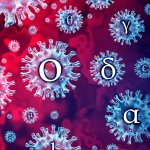Image source: Adobe Stock/Photocreo Bednarek
News • Effective prevention
Covid-19 vaccination greatly reduces infectious viral load
Measuring the viral load of people infected with SARS-CoV-2 is one of the main factors in evaluating the infectiousness of COVID-19 patients. Viral load can be influenced by the infecting SARS-CoV-2 variant as well as the vaccination status of the patient.
A research team from the University of Geneva (UNIGE) and the University Hospitals of Geneva (HUG) measured the infectious viral load of nearly 600 symptomatic patients to detect possible differences between the original virus, Delta and Omicron sublineage BA.1, as well as according to vaccination status. They discovered that Delta causes a higher viral load than the original virus and the Omicron variant. For Delta and Omicron breakthrough infections, vaccination drastically reduces the viral load. In the case of Omicron, however, the decrease was only observed after three doses of vaccine. Furthermore, Omicron’s very high infectiousness is seemingly related to factors other than viral load alone. These results, to be read in the journal Nature Medicine, highlight the benefit of vaccination for public health in addition to individual protection against the severe form of the disease, and remind us that variants of the virus must be closely monitored to prevent further massive outbreaks.
The notion of contagiousness is essential for deciding on collective prevention measures, such as periods of isolation
Isabella Eckerle
The diagnosis of Covid-19 consists of a PCR test performed on a nasopharyngeal or salivary swab. “This test is very effective in identifying infected people, but does not indicate whether they are infectious, that is, capable of transmitting the virus to other people,” says Isabella Eckerle, professor in the Department of Medicine at UNIGE Faculty of Medicine and head of the HUG-UNIGE Centre for Emerging Viral Diseases, who led this work. “However, the notion of contagiousness is essential for deciding on collective prevention measures, such as periods of isolation.”
PCR tests can only detect the presence of viral RNA, but do not indicate whether the virus is still intact and able to spread. The measurement of the infectious viral load necessarily involves culturing the virus for several days in a biosafety level 3 laboratory, a procedure impossible to perform routinely.
Since the beginning of the pandemic, samples taken at the HUG screening centre have been kept for research purposes, with the authorisation of the persons concerned. “We were able to reanalyze samples from previous waves of the disease,” explains Benjamin Meyer, a researcher at the Centre for Vaccinology in the Department of Pathology and Immunology at UNIGE Faculty of Medicine. “We measured the infectious viral load of 3 cohorts of patients during the first 5 symptomatic days to compare the viral load caused by the original virus (118 samples, spring 2020), the Delta variant (293 samples, fall 2021) and the Omicron variant sublineage BA.1 (154 samples, winter 2022), as well as, for the last two cohorts, whether a significant difference could be detected in vaccinated and unvaccinated individuals.”
Recommended article

News • Viral subtypes
Coronavirus evolution: 'Even Omicron has three variants'
Professor Richard Neher from the Biozentrum of the University of Basel is using his Nextstrain platform to investigate which variants of the SARS-CoV-2 virus are currently circulating worldwide.
Overall, the infectious viral load for the Delta cohort was significantly higher than that of the cohort with the original virus. However, people infected by Delta who received two doses of mRNA vaccine had a significantly lower infectious viral load than unvaccinated people. “For the Omicron cohort, contrary to what can be assumed given its rapid spread, the infectious viral load was overall lower than that of the Delta cohort,” says Isabella Eckerle. In contrast, only people who were boosted (that is, having received three doses of the vaccine) had their viral load decreased; people who received two doses only had no benefit in this regard compared to unvaccinated people. “This is immunologically consistent: many vaccines require 3 doses spaced several months apart to induce a sustained immune response, such as that against Hepatitis B virus”, explains Isabella Eckerle.
Why is the Omicron variant so contagious, if the viral load it induces is lower than its predecessors? “We still don’t know, but our data suggest that other infectious mechanisms are at play,” explains Pauline Vetter, clinic director at the HUG-UNIGE Center for Emerging Diseases. “It is now clear that the mutations of Omicron strongly differentiate it from other variants, allowing it to partially escape the vaccine, and diminish the effectiveness of some antiviral treatments used so far.” However, vaccination has been shown to be useful in limiting the occurrence of severe symptoms and most likely also the transmission of the virus. Indeed, in countries where the population, especially the elderly, is poorly vaccinated, Omicron has proven to be just as deadly.
The Geneva study also shows that the knowledge acquired for previous variants must be updated every time a new variant emerges to be able to adapt the means of combating Covid-19. “In view of our results, the greatest caution should be exercised in the face of a virus whose evolution is not fully understood, and against which currently existing treatments lose some of their effectiveness,” conclude the authors.
Source: University of Geneva
15.04.2022











